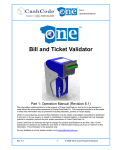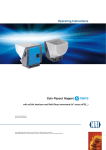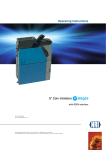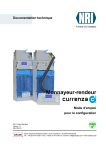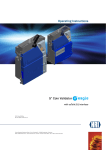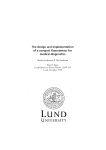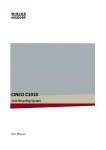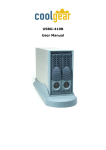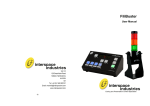Download Operating Instructions 3.5“ Coin Validator G-13.mft USB g
Transcript
Operating Instructions 3.5“ Coin Validator G-13.mft USB g with GDS interface 05.12 Hns/WP/Roe BA_G13mft_USBg_EN_1-1 Crane Payment Solutions GmbH | Zum Fruchthof 6 | 21614 Buxtehude | Germany Web: [email protected] | www.craneps.com | Phone: +49 (0) 41 61-729-0 | Fax: +49 (0) 41 61-729-115 G-13.mft USB g Table of contents Table of contents 1 Revision protocol 7 2 About ... 8 2.1 About these operating instructions 2.1.1 Text conventions 2.1.2 Additional useful technical documentation 8 8 9 2.2 About the G-13.mft USB g 2.2.1 The G-13.mft USB g features 9 9 3 Safety instructions 10 3.1 Proper use 10 3.2 Protecting persons and equipment 10 4Design 11 4.1 Top coin entry version 11 4.1.1 Coin route from top entry insert funnel to cash-box/ sorting chute or return area 12 4.2 Front coin entry version 13 4.2.1 Coin route from front entry insert funnel to cash-box/ sorting chute or return area 14 BA_G13mft_USBg_EN_1-1 4.3Label 15 4.4 Switch block 4.4.1 Switch functions of upper switch block S1 4.4.2 Switch functions of lower switch block S2 16 16 16 4.5 Coin return lever/button 17 4.6 Status LEDs 17 4.7Interfaces 17 3 Table of contents G-13.mft USB g 5Function 18 5.1 Coin acceptance and coin channels 18 5.2 Memory blocks 19 5.3 Accepted coin sensors 19 5.4 Control for external sorter 19 5.4.1 Sorting principle 19 2 5.4.2 Sorting with NRI 3-way standard sorter s SSD-3001 (option)20 5.4.3 NRI 3-way high-speed sorter s2 HSD-3000 (option) 20 5.5 Coin inhibition/activation of narrow coin channels 5.5.1 Inhibiting all coins/individual coin channels via machine control system 5.5.2 Inhibiting individual coins/coin channels using the switch blocks 21 5.6 Teach mode 21 6Start-up 6.1 Installing coin validator in the machine 21 21 22 22 6.2 Installing NRI 3-way standard sorter s2 SSD-3001 (option) 23 7Operation 8 9 24 7.1 Selecting the memory block 24 7.2 Inhibiting coins/activating narrow coin channel 7.2.1 Inhibiting functions – switch block S1 7.2.2 Inhibiting functions – switch block S2 25 25 25 7.3 Teaching coin channels in teach mode 27 Maintenance and service 29 8.1 Cleaning the coin runway 29 8.2Troubleshooting 30 What subsequent settings can be made? 31 9.1 On-site service tool HENRI+31 9.2 Which device functions can be set by data block upload? 31 4 BA_G13mft_USBg_EN_1-1 G-13.mft USB g Table of contents 10 Technical data 10.1 Device data 32 10.2Interfaces 10.2.1Pin assignment 33 33 10.2.1.1 G-13.mft USB g – machine (USB Mini-B) 10.2.1.2 G-13.mft USB g – power 10.2.1.3 G-13.mft USB g – external sorter 10.2.2GDS commands 10.3Accessories 10.3.1Sorters 10.3.2Front plates 11Index BA_G13mft_USBg_EN_1-1 32 33 33 33 34 34 34 34 35 5 G-13.mft USB g 1 BA_G13mft_USBg_EN_1-1 Revision protocol Revision protocol Version Revision Chapters/sections concerned _1-1 Front plate version 4 "Design" 10.3 "Accessories" 7 About ... 2 About ... 2.1 G-13.mft USB g This chapter is intended to provide a general overview of the advantages and options of the coin validator G-13.mft with serial USB GDS interface. The first section, however, is designed to help you navigate easily within these operating instructions. About these operating instructions These operating instructions describe the design and operation of the electronic 3.5" coin validator G-13.mft with serial USB GDS interface. Afterwards, chapters 6 and 7 explain the necessary steps for starting up and operating the coin validator. Chapter 7 describes how to clean the coin validator and remedy the cause of any malfunction. Chap. 10 "Technical data" and the appended "Index" reduce the search for specific explanations. 2.1.1 Text conventions To make it easier for you to navigate within these operating instructions and to operate the device, the following accentuations were made in the text: 8 Safety instructions which you must observe in order to protect operators and equipment. Special notes intended to facilitate the use of the coin validator. At the beginning of each chapter you will find a short "guide" which summarises the contents of the chapter. Device functions which are set or prepared by the manufacturer according to customer specifications and can be set or changed using our service and configuration tools (cp. Chap. "9 What subsequent settings can be made?", p. 31). 1 2 3 ... Requests to perform an action are numbered in another typeface. [Fig. 1/2] Reference to a figure. The number preceding the slash indicates the number of the figure, the number following the slash is the number of the item in the figure. BA_G13mft_USBg_EN_1-1 G-13.mft USB g 2.1.2 About ... Additional useful technical documentation Apart from the operating instructions you already have, further documentation is available for the G-13.mft, e.g. documentation concerning the mounting dimensions, configuration and spare parts. All documentation can be downloaded from the NRI homepage (www.nri.de) as pdf file. 2.2 About the G-13.mft USB g The G-13.mft coin validator with serial USB GDS interface in the standardised 3.5“ format uses the patented multi-frequency technology (MFT) for reliable coin validation. Communication with the machine control system takes place via the GDS dual connector solution consisting of a power connector and the Mini-B USB connector. Due to the interface and its compact design the G-13.mft is ideally suited for gaming machines & lottery terminals. For coin acceptance the coin validator has 32 coin channels which – divided into 2 x 16 coin channels – can be managed in two memory blocks with different coin configurations and selected individually. Depending on the application the coin validator can optionally be equipped with a 3-way sorter. To be able to react as quickly as possible to new fraud coins and to make your individual settings, the coin validator can be configured using our service & configuration tools. Any coins or tokens not taken into account by the manufacturer can be programmed in the teach mode directly on the coin validator without any configuration tools by inserting the coins. 2.2.1 The G-13.mft USB g features • Reliable acceptance of genuine coins and rejection of fraud coins due to MFT multiple sensing of the coins inserted and evaluation of 24 measuring parameters • Operating and manipulation safety provided by optical accepted coin sensors and sorting control in the coin validation and coin outlet area • Acceptance speed of two coins per second • 32 coin channels managed in two independently configured and individually selectable memory blocks (2 x 16 coin channels) • Serial interface –– flexible and extensive communication with the machine controller –– easy control of device functions –– economical device design –– industry standard GDS protocol • Teach mode for eight coin channels • Service interface for configuration tools • Flash technology for easy and time-saving firmware updates (WinFlash2) • Options –– 3-way standard sorter –– 3-way high-speed sorter –– Front plates for front plate version BA_G13mft_USBg_EN_1-1 9 Safety instructions 3 G-13.mft USB g Safety instructions Before starting up the device for the first time, please read these instructions and in particular the safety instructions carefully at least once. This is to ensure that you have understood the contents of this manual and how to operate the coin validator. 3.1 Proper use The electronic 3.5“ coin validator G-13.mft with serial USB GDS interface is intended for use in gaming machines with serial GDS interface and is designed to check the coins inserted into the machine for specific properties and to accept (and sort) or reject them. Use the coin validator exclusively for this purpose. Under no circumstances can the manufacturer be held liable for any damage or loss resulting from improper use of the device. The coin validator has been built in accordance with state-of-the-art standards and the recognised safety rules. Nevertheless, this equipment can constitute a source of danger. Please observe therefore the following safety instructions. 3.2 Protecting persons and equipment The coin validator may only be connected by a qualified electrician. Use the coin validator only in accordance with its proper use. Under no circumstances can the manufacturer be held liable for any damage or loss resulting from improper use of the device. The coin validator PCB is fitted with components which may be damaged beyond repair by electrostatic discharges. Please observe the handling instructions for components exposed to the risk of electrostatic discharge. Select the correct voltage for the coin validator (see label). Never pull the connecting cable of the coin validator from the machine when a voltage is applied. Pull the mains plug of the machine before installing, cleaning or removing the coin validator. Contact NRI if you want to modify the device beyond the scope of the modifications or attachments described here. Keep water and other liquids away from the coin validator. Please dispose of the device correctly at the end of its service life. We reserve the right to make technical modifications to the device which are not covered by these instructions! 10 BA_G13mft_USBg_EN_1-1 G-13.mft USB g 4 Design Design This chapter describes • the main parts the G-13.mft USB GDS consists of, and • all parts required for the operation of the coin validator. 4.1 Top coin entry version 14 13 9 1 12 11 2 10 3 9 4 5 6 9 8 7 Fig. 1: Design – G-13.mft USB g – top entry version 1 Switch blocks 2 Brief description of switch functions 8 Coin outlet – return 9 Mounting stud 3 Interface – sorter 10 Flight deck 4 Interface – power 11 Label 5 Interface – machine (USB Mini-B) 12 Status LEDs 6 Interface – service/configuration 13 Coin insert funnel 7 Coin outlet – cash-box/sorter 14 Coin return lever BA_G13mft_USBg_EN_1-1 11 Design 4.1.1 G-13.mft USB g Coin route from top entry insert funnel to cash-box/sorting chute or return area return area cash-box/ sorting device Fig. 2: Coin path – top entry version 12 BA_G13mft_USBg_EN_1-1 G-13.mft USB g 4.2 Design Front coin entry version 14 8 MINI 1 13 12 2 11 3 10 4 9 5 14 6 7 8 MIDI Fig. 3: Design – G-13.mft USB g – front entry version with front plate 1 Switch blocks 2 Brief description of switch functions 8 Coin outlet – return 9 Mounting stud 3 Interface – sorter 10 Flight deck 4 Interface – power 11 Label 5 Interface – machine (USB Mini-B) 12 Status LEDs 6 Interface – service/configuration 13 Coin insert funnel 7 Coin outlet – cash-box/sorter 14 Coin return button BA_G13mft_USBg_EN_1-1 13 Design G-13.mft USB g 4.2.1 Coin route from front entry insert funnel to cash-box/sorting chute or return area return area cash-box/ sorter Fig. 4: Coin path – front entry version 14 BA_G13mft_USBg_EN_1-1 G-13.mft USB g 4.3 Design Label The label of the coin validator [Fig. 1/11] [Fig. 3/11] contains all data defining the device such as device number and type, operating voltage and customer-specific currency and coin programming: 1 2 3 4 5 17 16 15 CDD,-05 CDD,-05N CDD,-05N1 CDD,-10 CDD,-10N CDD,-25 CDD,-25N 5 1 2 CDD,-50N 3 CDD,-50N1 /g GDS CDD1,452-038 CDD1,-N 123456 / 001 00012345 CDD2,CDD2,-N 01 02 03 04 05 06 14 07 15 08 09 10 16 11 12 13 6 7 01 01 01 02 02 03 03 04 04 05 05 06 06 CDD,-05 CDD,-05N CDD,-05N1 CDD,-10 CDD,-10N CDD,-25 CDD,-25N CDD,-50N CDD,-50N1 CDD1,CDD1,-N CDD2,CDD2,-N 01 02 03 04 05 06 14 07 15 08 09 10 16 11 12 13 01 01 01 02 02 03 03 04 04 05 05 06 06 11 14 13 12 11 10 9 8 Fig. 5: Label 1 Coin programming – memory block 0 (if DIL switch S1.10 set to OFF) 2 Currency & denomination – memory block 0: N, N1, N2 etc. = new coins in circulation 3 Channel no. normal coin channel – memory block 0 8 Nominal voltage 9 Bar code 10 Date of manufacture 11 Device serial no. per order no. (3-digit) 12 Ordering code (6-digit) 13 Order number (6-digit) 14 Firmware version 4 Channel no. narrow coin channel – memory block 0 15 Device type 5 Channel no. very narrow coin channel – memory block 0 17 Model number 6 Coin type – memory block 0 16 Data block & revision number 7 Coin programming – memory block 1 (if DIL switch S1.10 set to ON) BA_G13mft_USBg_EN_1-1 15 Design G-13.mft USB g 4.4 Switch block The coin validator has two switch blocks [Fig. 1/1] [Fig. 3/1] with ten DIL switches S1.1‑10 and S2.1–10 on the rear of the device. The DIL switches can be used to set certain device functions: For details on how to use the switch block to set the individual functions, see Chap. "7 Operation", p. 24. 4.4.1 On the rear of the device you will find a brief description of the individual switch functions. Switch functions of upper switch block S1 DIL switch Function S1.1 Coin channel 1 ON inhibited S1.2 Coin channel 2 enabled inhibited S1.3 Coin channel 3 enabled inhibited S1.4 Coin channel 4 enabled inhibited ON OFF S1.5 Coin channel 5 enabled inhibited S1.6 Coin channel 6 enabled inhibited S1.7 Coin channel 7 enabled inhibited S1.8 Coin channel 8 enabled inhibited S1.9 used 0 1 S1.10 4.4.2 Memory block Switch functions of lower switch block S2 DIL switch Function OFF ON S2.1 Coin channel 9 enabled inhibited S2.2 Coin channel 10 enabled inhibited S2.3 Coin channel 11 enabled inhibited S2.4 Coin channel 12 enabled inhibited S2.5 Coin channel 13 enabled inhibited S2.6 Coin channel 14 enabled inhibited S2.7 Coin channel 15 enabled inhibited S2.8 Coin channel 16 enabled inhibited S2.9 Mode normal mode teach mode In teach mode normal band wide band S2.10 16 OFF enabled ON OFF BA_G13mft_USBg_EN_1-1 G-13.mft USB g 4.5 Design Coin return lever/button The return lever [Fig. 1/14] on the top of the device is operated using the return button on the machine when coins which have been inserted are to be returned or e.g. a jam caused by coins which have become stuck needs to be removed. Actuation of the return lever opens the measurement and validation area of the coin validator so that all objects in the coin validator are directed to the return area. Devices with front entry through a front plate do not have a return lever. Here the measurement and validation area is opened by pressing the return button [Fig. 3/14] on the front plate. 4.6 Status LEDs Three status LEDs [Fig. 1/12] [Fig. 3/12] on the left-hand side of the G-13.mft USB g indicate the operating state: Green LED connection ok, coin validator enabled, ready to accept coins Red LED connection ok, coin validator disabled no connection, coin validator disabled 4.7 Interfaces For details of the machine and sorter interfaces [Fig. 1/3–5] [Fig. 3/3–5] please refer to Chap. "5 Function", p. 18 and Chap. "10 Technical data", p. 32. BA_G13mft_USBg_EN_1-1 17 Function 5 G-13.mft USB g Function This chapter describes how the coin validator works: • Coin acceptance and coin channels • Memory blocks • Accepted coin sensors • Control for external sorter • Coin inhibition/activation of narrow coin channels • Teach mode 5.1 Coin acceptance and coin channels For coin acceptance the coin validator has 32 "memory slots" to which up to 32 different coin types or tokens can be assigned. These "memory slots" are called coin channels. The acceptance band of one coin type/token is assigned to each coin channel and the respective coin type/ token is accepted in this channel. After a reset, coin acceptance is inhibited and must be enabled by the machine. To enable reliable rejection of fraud coins, channels with a narrow or even very narrow acceptance band are frequently set up for a coin type in addition to the normal coin channel. The limit values of these coin channels are closer to one another so that fraud coins with similar measured values are rejected, if the normal channel is inhibited (cp. Chap. "7.2 Inhibiting coins/activating narrow coin channel", p. 25). Narrow and very narrow coin channels, however, also feature a lower acceptance rate. In addition, it is possible to assign coins with different measured values but identical coin values to different coin channels. In this way the coin validator can accept e.g. old and new coins of the same denomination. In addition to the acceptance band of a coin type, further coin information which defines further processing of the coin after its acceptance is assigned to a coin channel: e.g. the coin type and value or sorting information for an external sorter. Since in most cases not all coin channels are assigned by customised factory programming, further coin types and the desired information can be assigned to these free channels at any time using the NRI configuration and service tools. Existing configurations can be changed. Eight coin channels are intended to be used for the teach mode. In these teach channels new tokens/coin types can be taught also without configuration and service tools, directly on the coin validator using the switch block; i. e. a new coin or token is assigned to a channel (cp. Chap. "5.6 Teach mode", p. 21). 18 BA_G13mft_USBg_EN_1-1 G-13.mft USB g 5.2 Function Memory blocks The G-13.mft USB g manages two separately programmed (memory) blocks 0 and 1 (cp. Chap. "4.3 16 coin channels with different coin types (also currencies), sorting information etc. can be assigned to each block. Only one block at a time can be active and used for coin measurement and further coin processing. You can use the switch block on the device to select the desired block (cp. Chap. "7.1 Selecting the memory block", p. 24). Label", p. 15). 5.3 Accepted coin sensors To ensure that accepted coins actually arrive in the cash-box or an external sorter and that acceptance has not been tampered with, accepted coin sensors (light barriers) check whether the inserted coin drops unhindered through the coin outlet towards the cash-box or sorter. Only when the coin has passed this checking device, either coin acceptance or, in case of tampering, an error code is transmitted to the machine. If the accepted coin sensors are continuously covered, e.g. by a coin pile-up, coin acceptance is inhibited. 5.4 Control for external sorter To direct accepted coins either to the cash-box or an external sorter, e.g. change tubes or hoppers, the coin validator can be equipped with an NRI 3-way sorter or another 3-way sorter at the coin outlet. 5.4.1 Sorting principle The sorting gates are activated via two sorting control lines on pins 3 and 4 of the 10-pole sorter connector [Fig. 1/3] on the rear of the coin validator (cp. Chap. "10.2.1.3 G-13.mft USB g – external sorter", p. 33). Which coin is sorted via which sorting control line is set by the machine control system. Assignment coin type – sorting control line and sorting time (how long shall the sorting gates be controlled? 300–1000ms). BA_G13mft_USBg_EN_1-1 While the coin validator is sorting an accepted coin (= sorting time) it cannot accept any further coins unless the same sorter path is addressed. If an external sorter is no longer required and the sorting time is not set to zero, the coin acceptance speed will continue to be reduced by the preset sorting time. For faster coin acceptance, the sorting time should therefore be set to zero. 19 Function 5.4.2 G-13.mft USB g Sorting with NRI 3-way standard sorter s2 SSD-3001 (option) When the optional NRI 3-way standard sorter s2 SSD-3001 is used the individual coin types can be distributed to the three chutes independent of their dimensions. Each chute can be defined as cash-box chute.The following table shows which sorting control line must be activated in order to sort coin into a specific sorting chute: Sorting chute Sorting control line left 6 (pin 4) middle – right 5 (pin 3) For details on how to connect the NRI sorter to the coin validator, see Chap. "6.2 Installing NRI 3-way standard sorter s2 SSD-3001 (option)", p. 23. te ht hu rig n c r tu Re le idd m t lef Fig. 6: Sorting chutes of s2 SSD-3001 sorter 5.4.3 NRI 3-way high-speed sorter s2 HSD-3000 (option) You may also connect the NRI high-speed sorter with three sorting chutes and monitored coin inlet and outlet. For the pin assignment of the sorer interface please refer to Chap. "10.2.1.3 G-13.mft USB g – external sorter", p. 33. The mounting dimensions are stated in the separate HSD-3000 data sheet. 1 2 3 Fig. 7: s2 HSD-3000 20 BA_G13mft_USBg_EN_1-1 G-13.mft USB g 5.5 Function Coin inhibition/activation of narrow coin channels If coins are no longer to be accepted for payment on the machine you can either • inhibit coin acceptance completely, • inhibit all coin channels of a certain coin to ensure that this coin is no longer accepted, or • inhibit the normal coin channel of a certain coin so that this coin is accepted only in the narrow channel. 5.5.1 After a reset, coin acceptance is inhibited and must be enabled by the machine. Inhibiting all coins/individual coin channels via machine control system The control system can • inhibit coin acceptance completely. In this case the coin validator does not accept any coins. • inhibit all coin channels of a certain coin, e.g. if there is no more change in an external payout unit or in case of high fraud hazard. • inhibit the normal coin channel of a certain coin so that this coin is accepted only in the narrow channel. How to program the inhibit or enable functions is described in the machine manual. For details on the serial interface please refer to the specification "GDS® COIN ACCEPTOR: COMMUNICATION PROTOCOL, Gaming Device Standard", made available to GSA members on the Internet at "www.gamingstandards.com". 5.5.2 Inhibiting individual coins/coin channels using the switch blocks As an alternative to inhibition via the control system, the coin validator is provided with two switch blocks for inhibiting coin channels on site (cp. Chap. "7.2 Inhibiting coins/activating narrow coin channel", p. 25). Alternatively: deactivate individual coin types on a long-term basis 5.6 Teach mode Coin channels can be taught in the teach mode without configuration software via the switch blocks on the coin validator, i. e. a new token or coin is assigned to a coin channel. The new acceptance band is generated by inserting the tokens/coins. It is not necessary to remove the coin validator from the machine for this purpose. The last eight coin channels 9–16 (= teach channels) of the activated memory block are available for teaching (cp. Chap. "7.3 Teaching coin channels in teach mode", p. 27). Activate/deactivate teach mode/channels BA_G13mft_USBg_EN_1-1 21 Start-up 6 G-13.mft USB g Start-up For all installation work on the coin validator or the machine please observe the following safety instructions: • The coin validator may only be connected by a qualified electrician. • Do not use the coin validator if the device or connecting cable are damaged . • Make sure that the correct supply voltage is connected (see label). • Never pull the connecting cable of the coin validator from the machine when a voltage is applied. • Pull out the machine’s mains plug before you install or remove the coin validator. 6.1 Installing coin validator in the machine To install the G-13.mft USB g in a machine with GDS interface: 1 If necessary make individual settings via the switch blocks [Fig. 8/1] (cp. Chap. "7 Operation", p. 24). 2 Disconnect the machine from the mains supply. 3 Connect the sorter, if any, to the coin validator using the 10-pin sorter interface [Fig. 8/2] 4 Power the coin validator using interface [Fig. 8/3] 5 Connect the coin validator to the machine using the USB Mini-B interface [Fig. 8/4]. 6 Hang up the coin validator in the machine using the lateral mounting studs [Fig. 8/5]. 7 Reconnect the mains supply to the machine. 5 1 5 2 3 4 1 Switch blocks 2 Interface – sorter 3 Interface – power 4 Interface – machine (USB Mini-B) 5 5 Mounting studs Fig. 8: Installation 22 BA_G13mft_USBg_EN_1-1 G-13.mft USB g 6.2 Start-up Installing NRI 3-way standard sorter s2 SSD-3001 (option) If you want to operate the G-13.mft with the NRI s2 SSD-3001, you must install the sorter on the validator as follows: 1 If necessary, fasten chute extension [Fig. 9/1] with screw [Fig. 9/2] to sorting device [Fig. 9/3]. 2 Fasten mounting frame [Fig. 9/4] by means of screws [Fig. 9/5, 6] to the rear of the sorter. 3 Hang the coin validator by its mounting studs [Fig. 9/7] in the mounting frame. 4 Use the 10-pin sorter plug [Fig. 9/8] on the PCB [Fig. 9/9] and on the rear of the coin vali- dator to connect the sorter to the G-13.mft with the help of the appropriate sorting cable. 5 Connect coin validator to the machine (cp. Chap. "6.1 Installing coin validator in the machine", p. 22). 4 7 5 6 7 1 3 2 9 8 Fig. 9: Attaching s2 SSD-3001 to G-13.mft BA_G13mft_USBg_EN_1-1 23 Operation 7 G-13.mft USB g Operation This chapter describes how to operate the coin validator, i. e. set certain functions on the coin validator: • Selecting the memory block • Inhibiting coins/activating narrow coin channel • Teaching coin channels in teach mode The settings which are made directly on the coin validator are described. A separate instruction manual describes how to make settings using our service & configuration tools (cp. Chap. "9 What subsequent settings can be made?", p. 31). Chap. "5 Function", p. 18 7.1 describes the functions of the adjustable device options. Selecting the memory block If the coin validator is to access the other memory block and e.g. accept another currency, the correct block can be selected using the upper switch block: 1 Unhook the coin validator from the machine. 2 For memory block 1 set DIL switch S1.10 to ON (up), for memory block 0 set the DIL switch to OFF (down). Memory block 0 selected Memory block 1 selected 3 Remount coin validator in the machine. 4 Switch power off and on again. The required memory block is activated. 5 Check coin acceptance of the new memory block selected. 24 BA_G13mft_USBg_EN_1-1 G-13.mft USB g 7.2 Operation Inhibiting coins/activating narrow coin channel Using the two switch blocks on the coin validator each of the 16 coin channels of the memory block activated or each coin type assigned to specific coin channels can be inhibited individually, i. e. the inhibited coin channels will no longer be used for payment on the machine. • Accepting coin without any limitations: all coin channels assigned enabled • Narrowing coin acceptance band: normal coin channel inhibited • Inhibiting coin: all coin channels assigned inhibited The 16 DIL switches inhibit the following coin channels: 7.2.1 Inhibiting functions – switch block S1 DIL switch Function OFF ON S1.1 Coin channel 1 accepts inhibited S1.2 Coin channel 2 accepts inhibited S1.3 Coin channel 3 accepts inhibited S1.4 Coin channel 4 accepts inhibited S1.5 Coin channel 5 accepts inhibited S1.6 Coin channel 6 accepts inhibited S1.7 Coin channel 7 accepts inhibited S1.8 Coin channel 8 accepts inhibited 7.2.2 Inhibiting functions – switch block S2 DIL switch Function OFF ON S2.1 Coin channel 9 accepts inhibited S2.2 Coin channel 10 accepts inhibited S2.3 Coin channel 11 accepts inhibited S2.4 Coin channel 12 accepts inhibited S2.5 Coin channel 13 accepts inhibited S2.6 Coin channel 14 accepts inhibited S2.7 Coin channel 15 accepts inhibited S2.8 Coin channel 16 accepts inhibited Please refer to the label of the device to see which coin type has been assigned to which coin channels at the factory. BA_G13mft_USBg_EN_1-1 However, this assignment could have been changed using the configuration software. On the rear of the device you will find a brief description of the individual switch functions. 25 Operation G-13.mft USB g If all coin types are to be accepted for payment at the machine without any limitations, the DIL switches S1.1–S1.8 and S2.1–S2.8 of the two switch blocks are in the lower position (OFF). If you want to inhibit a coin channel, you only need to move the respective DIL switch toward the top to ON. Example The coin validator is no longer supposed to use coin channels 3 and 10 for coin acceptance, which means that coin channels 3 and 10 must be inhibited With the DIL switches in these positions, coin channels 3 and 10 will no longer be used! If a normal coin channel and a narrow coin channel have been programmed on the coin validator for one coin type, the normal coin channel must be inhibited as described above in order to activate the narrow coin channel. If both channels are activated, the wider acceptance band of the normal coin channel is used. If a coin type is to be inhibited, both coin channels must be inhibited. To inhibit coin channels on the validator: 1 Unhook the coin validator from the machine. 2 Inhibit the desired coin channels using the DIL switches S1.1–8 and S2.1–8 (cp. example above). The desired coin channels are inhibited. 3 Hang the coin validator back in the machine. 26 BA_G13mft_USBg_EN_1-1 G-13.mft USB g 7.3 Operation Teaching coin channels in teach mode To generate new acceptance bands, up to eight coin channels (teach channels) can be taught using the lower switch block on the coin validator. You need at least ten coins/tokens of the new type. The following DIL switches of switch block 2 have the following functions: DIL switch Function OFF ON S2.1 Teach mode – teaching teach channel 9 S2.2 Teach mode – teaching teach channel 10 S2.3 Teach mode – teaching teach channel 11 S2.4 Teach mode – teaching teach channel 12 S2.5 Teach mode – teaching teach channel 13 S2.6 Teach mode – teaching teach channel 14 S2.7 Teach mode – teaching teach channel 15 S2.8 Teach mode – teaching teach channel16 S2.9 Teach mode OFF ON S2.10 Teach mode normal acceptance band wide acceptance band Proceed as follows to assign a new coin/token to a coin channel 9–16 of the activated memory block: Keep the current switch settings in mind so that you can restore them easily for the normal operating mode at the end 1 Unhook the coin validator from the machine. 2 Set all DIL switches S2.1-10 to OFF (down). 3 Set DIL switch S2.9 to ON (up). The device is in the teach mode for teaching the coin channels. S2 S2 4 Select the coin channel to be taught (9–16, here: 11) by setting the respective DIL switch (S2.1–8, here: S2.3) to ON (up). S2 5 Insert at least 10 coins of the new coin type/token into the coin validator or machine. After the 10th coin has been inserted, the acceptance gate is operated once (brief clacking sound). Further coins can be inserted. If there is no signal after the 10th coin has been inserted, the coins inserted cannot be used. Now you can save the measured values generated by the inserted coins with a normal (a) or a wide (b) acceptance band. A wide acceptance band is an appropriate choice when you only have a limited selection of coins at your disposal for the purpose of teaching tokens. BA_G13mft_USBg_EN_1-1 27 Operation G-13.mft USB g To save with the normal acceptance band: 6a Set DIL switch S2.9 back to OFF (down). Successful saving is signalled by the acceptance gate S2 attracting once (brief cracking sound). A saving error is signalled by the acceptance gate attracting twice (brief cracking sounds), if e.g. the acceptance band of the coins inserted and the acceptance band of a coin channel already programmed overlap, or the measured values generated are too different and the tolerances would become too large. To cancel the process first set the DIL switch of the respective coin channel (S1–8, here: S2.3) and then DIL switch S2.9 to OFF (down). To save with the wide acceptance band: 6b Set DIL switch S2.10 to ON (up). The acceptance band has been widened. S2 Now you can set DIL switch S2.9 to OFF (down) again. Successful saving is signalled by the acceptance gate attracting once (brief cracking sound). A saving error is S2 signalled by the acceptance gate attracting twice (brief cracking sounds), if e.g. the acceptance band of the coins inserted and the acceptance band of a coin channel already programmed overlap, or the measured values generated are too different and the tolerances would become too large. To cancel the process first set the DIL switch of the respective coin channel (S2.1–8, here: S3) and DIL switch S2.10 for the wide acceptance band and then DIL switch S2.9 to OFF (down). 7 Set DIL switches S2.1–8, if necessary, for normal operating mode (cp. Chap. "7.2 Inhibiting coins/ activating narrow coin channel", p. 25). 8 Remount the coin validator in the machine. 9 Switch power off and on again. 10 Enable the taught coin channel (here: 11) via the control system and adapt sorting, if necessary. The coin validator will now accept the new coin type/token for payment. 28 BA_G13mft_USBg_EN_1-1 G-13.mft USB g 8 Maintenance and service Maintenance and service This chapter describes how to • clean the G-13.mft and • remedy the cause of malfunctions. 8.1 Cleaning the coin runway On their way through the coin validator the coins may leave residues on sensitive parts which must be removed from time to time to ensure reliable coin acceptance and rejection. Apart from this, no further maintenance work is required. • Cleaning interval: as required, minimum once per year • Cleaning agent/tool: compressed air/small brush/moistened cloth, lukewarm water Moisten the cloth only slightly to prevent fluid from entering the device. This would damage the PCB. Do not use any solvents or scouring agents which attack the plastic material of the device. 1 Pull the mains plug of the machine. 2 Carefully open the flight deck [Fig. 10/1] on the left-hand side and hold it open. 3 Clean the coin runway in the coin validator using compressed air/brush or a cloth. 4 Remove dust and coin residues from the validation area using cloth/brush or compressed air. 5 Wipe the two sides of the coin runway clean using a slightly moistened cloth. 6 Allow all parts to dry. 7 Close flight deck again. 8 Reconnect the machine to the mains supply. 1 Fig. 10: Opening the flight deck of the coin validator BA_G13mft_USBg_EN_1-1 29 Maintenance and service 8.2 G-13.mft USB g Troubleshooting Malfunctions can occur in all electronic devices. These do not always have to be faults in the device. In many cases improper connections or incorrect settings are the reason. Therefor: please check first of all whether the malfunction can simply be remedied using the following table. Problem Possible cause Remedy, hints Red LED Coin validator disabled Enable coin validator No connection, coin validator disabled Connect (cp. Chap. "6.1 Installing coin validator in the machine", p. 22) and enable coin validator Coin validator does not accept coin • Connect cable to validator and machine correctly (cp. Chap. "6.1 No power supply Installing coin validator in the machine", p. 22) • Supply machine with voltage Return lever pressed/got stuck Coin runway dirty Ensure that return lever is not permanently pressed by error Open flight deck and clean coin runway (cp. Chap. "8.1 Cleaning the coin runway", p. 29) • Make sure that machine control system does not inhibit coin acceptance Coin inhibited • Make sure that the coin is not inhibited using DIL switch on the rear of the device, or that not only the narrow coin channel is enabled and the normal one is inhibited (cp. Chap. "7.2 Inhibiting coins/activating narrow coin channel", p. 25) Coin validator accepts coin, but no credit is given Coin does not exit the device Make sure that the coin outlet is not blocked by foreign objects or devices connected to the bottom of the coin validator If the malfunction cannot be remedied please contact our service technicians. 30 BA_G13mft_USBg_EN_1-1 G-13.mft USB g 9 What subsequent settings can be made? What subsequent settings can be made? This chapter provides general information concerning the NRI service and configuration tool for the G-13.mft USB g and the device functions which can be configured subsequently. 9.1 On-site service tool HENRI+ For on-site configuration we recommend the HENRI+ service tool by which you can update the complete coin and device configuration quickly and reliably via individual data block upload. The separate short reference guide describes how to connect and use the tool. HENRI+ is also suitable for on-site firmware updates. 9.2 Which device functions can be set by data block upload? Uploading a customised data block current coin and device data: • Acceptance of genuine coins and rejection of fraud coins (acceptance band adjustment) • Attraction time of the acceptance gate • Coin via channel assignment of –– coin value –– coin type • Sorting via –– channel assignment of sorting control line –– sorting time • Deactivation/activation of coins on a long-term basis • Deactivation/activation of teach mode/teach channels • New coins/tokens (generation of a new acceptance band and assignment of the coin/sorting data) BA_G13mft_USBg_EN_1-1 31 Technical data 10 G-13.mft USB g Technical data This chapter contains • all relevant G-13.mft USB g data • details of machine and sorter interfaces • information concerning G-13.mft USB g accessories 10.1 Device data Supply voltage 10V to 16V DC Current consumption Standby mode: < 30mA Measuring mode: approx. 100mA Coin acceptance: approx. 100mA+ approx. 3W Temperature range -25°C to 70°C Temperature change 0.2 °C/min. max. Rel. humidity Up to 93% Condensation Not permitted Machine interface USB Mini-B, version 2.0, full speed compliant, human interface device (HID) class Protocol in compliance with Interface Specification "GDS® COIN ACCEPTOR: COMMUNICATION PROTOCOL, Gaming Device Standard" (made available to GSA members on the Internet at "www.gamingstandards.com") For pin assignment refer to Chap. "10.2.1.1 G-13.mft USB g – machine (USB Mini-B)", p. 33 Sorter interface 10-pin connector Coin acceptance 32 coin types max. in 2 x 16 channels Coin diameter: 15–31.5mm (optionally up to 32.5mm) Coin thickness: 1.5–2.5mm (optionally up to 3.3mm) Speed: 2 coins/s Device dimensionsHeight:102mm Width:89mm Depth:52mm For mounting dimensions, see separate documentation Mounting position Vertical, max. deviation: ± 2° Directives applied EMC:2004/108/EC EN 55 014-2 (interference resistance) EN 55 022 (interference emission) Machinery:2006/42/EC R&TTE:1999/5/EC (Radio and telecommunications terminal equipment) (cf. Declaration of Conformity) 32 BA_G13mft_USBg_EN_1-1 G-13.mft USB g 10.2 Technical data Interfaces The following pages show pin assignment for the connection of the coin validator to • the machine • an external sorter 10.2.1 Pin assignment 10.2.1.1 G-13.mft USB g – machine (USB Mini-B) Pin Function red 2 Data- white 3 Data+ green- 4 ID (not connected) none 5 black GND 10.2.1.2 5 4 3 2 1 Colour 1 VCC, +5V You will find a detailed description of the serial GDS interface in the "GDS® COIN ACCEPTOR: COMMUNICATION PROTOCOL, Gaming Device Standard" (made available to GSA members on the Internet at "www.gamingstandards.com"). G-13.mft USB g – power 1 Pin Function 1 12V 4 2 GND 3 GND 4 +24V 10.2.1.3 G-13.mft USB g – external sorter Pin Function BA_G13mft_USBg_EN_1-1 Level 1 GND GND 2 Sensor supply 12V DC - 3 Activate bottom switch, sorter path 2, open collector lo 4 Activate top switch, sorter path 1, open collector lo 5 Activate sensors, open collector lo 6 Switch supply 12 V DC - 7 Coin entry sensor covered/not covered hi/lo 8 Coin outlet sensor covered/not covered hi/lo 9 (Lower gate active/not active) lo/hi 10 (Upper gate active/not active) lo/hi 1 2 9 10 33 Technical data 10.2.2 G-13.mft USB g GDS commands You will find a detailed description of the serial GDS protocol in the "GDS® COIN ACCEPTOR: COMMUNICATION PROTOCOL, Gaming Device Standard" (made available to GSA members on the Internet at "www.gamingstandards.com"). 10.3 Accessories 10.3.1 Sorters Designation Order no. s2 SSD-3001/3002/3003/3004 3-way standard sorter s2 HSD-3000 3-way high-speed sorter 10.3.2 Order no. depends on position of return chute, type of mounting device and cable, please contact our sales staff 30500 You will find detailed information about the NRI standard and high-speed 3-way sorters in separate datasheets. All documentation can be downloaded from the NRI website (www.nri.de) as pdf file. Front plates Designation Order no. with white return button 5505 with black return button 19329 with white return button 22569 with black return button 23097 MIDI (black, 155 x 63mm) MINI (black, 120 x 60mm) 34 BA_G13mft_USBg_EN_1-1 G-13.mft USB g 11 Index 3-way sorting 20 A Accentuations in the text 8 Acceptance Band 18 Narrow 18 New 21 New, procedure 27 Normal 18 Very narrow 18 Coins 18, 32 Inhibit 21 Inhibit, procedure 25 Speed 32 Accepted coin sensor 19 Accessories 34 Advantages 9 Angle, mounting position 32 Application, proper 10 B Bar code 15 Block 15, 19 Select 24 C Change Tubes 19 Units 19 Channels 18 Inhibit 21 Procedure 25 Narrow 18 New 21 Procedure 27 Normal 18 Very narrow 18 Chapter summary 8 BA_G13mft_USBg_EN_1-1 Index Cleaning 29 Coin Acceptance 18, 32 Inhibit 21 Inhibit, procedure 25 Channels 18 Inhibit 21 Inhibit, procedure 25 Narrow 18 New 21 New, procedure 27 Normal 18 Very narrow 18 Diameter 32 Flight deck Open/clean 29 Inhibit 21 Insert funnel 11, 13 New 21 Procedure 27 Outlet 11, 13 Path 12, 14 Runway 12, 14 Teaching 21 Thickness 32 Tubes 19 Condensation 32 Configuration 8, 24, 31 On site (HENRI+) 31 Connection 22 Connectors External sorter 11, 13 GDS (USB/power) 11, 13 Pin assignment 33 Service/configuration 11, 13 Current consumption 32 35 Index D Data block Number 15 Upload 31 Date of manufacture 15 Design 11 Deviation, mounting position 32 Device Dimensions 32 Number 15 Type 15 DIL switch 11, 13, 16 Inhibit coins 25 Selecting memory block 24 Teaching coins 27 Dimensions 32 Documentation, additional 9 E Electrostatic discharge 10 Employment, proper 10 Error correction 30 F Firmware update 31 Flight deck 11, 13 Open/clean 29 Front plates Design 13 Order no. 34 Function 18 G GDS Interface 11, 13, 32, 33 Protocol specification 33 General information Chapter 8 Coin validator 9 Instructions 8 Guide, chapter contents 8 H HENRI+ 31 Adjustable functions 8, 31 Homepage, NRI 9 Hopper 19 36 G-13.mft USB g HSD-3000 sorter 20 Order no. 34 Humidity 32 I Inhibit Coin channels 21 Procedure 25 Coins 21 Procedure 25 Insert funnel 11, 13 Instructions Additional 9 In the text 8 Interface External sorter 11, 13, 33 GDS 11, 13, 32, 33 Label 15 Service/configuration 11, 13 Internet address, NRI 9 Introduction Chapter 8 Coin validator 9 Instructions 8 L Label 15 M Malfunction, what to do? 30 Manuals, additional 9 Manufacture date 15 Marks in the text 8 Measured values 18 Measures 32 Memory block 15, 19 Select 24 MIDI front plate Design 13 Order no. 34 MINI front plate Design 13 Order no. 34 Model number 15 Mounting Dimensions 32 Position 32 Stud 11, 13 BA_G13mft_USBg_EN_1-1 G-13.mft USB g Index N S New coin 21 Teach 27 Nominal voltage 15 s2 HSD-3000 sorter (option) 20 Order no. 34 Pinning, sorter interface 33 SSD-3001 sorter (option) 20 Safety instructions 8, 10 Serial number 15 Service/configuration 31 Settings 8, 24, 31 On site (HENRI+) 31 Software update 31 Sorting 19 Chute 11, 13 Control 19 NRI 3-way high-speed sorter (option) 20 With NRI 3-way standard sorter (option) 20 Start-up 22 Summary, chapter 8 Supply voltage 32 Switch blocks 11, 13 Description 16 Inhibit coins double block data-management 25 Selecting memory block 24 Teaching coins 27 Symbols in the text 8 O Open coin validator 29 Operating Instructions, additional 9 Voltage 32 Operation 24 Order number Accessories 34 Coin validator 15 P Payout units 19 Pictographs in the text 8 Pin assignment 33 Plug External sorter 11, 13 Pin assignment 33 GDS 11, 13, 32 Pin assignment 33 Service/configuration 11, 13 Power Connector 11, 13 Pin assignment 33 Consumption 32 Supply 32 Programming 8, 31 On site (HENRI+) 31 Proper use 10 R Relative humidity 32 Requests to perform an action 8 Return 11, 13 Lever 11, 13 Description 17 T Teach coins 21 Procedure 27 Technical data 32 Temperature Change 32 Range 32 Tilt, mounting position 32 Troubleshooting 30 Tubes 19 U Update firmware 31 Use, proper 10 W Web site, NRI 9 www.nri.de 9 BA_G13mft_USBg_EN_1-1 37





































